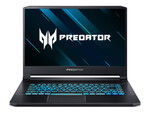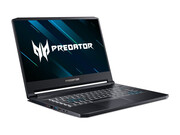Acer Predator Triton 500 PT515-51-73G6
Especificaciones de Portátil(es)

Price comparison
Promedio de 2 puntuaciones (de 3 análisis)
Análisis para el Acer Predator Triton 500 PT515-51-73G6
Origen: Techradar
 EN→ES Archive.org version
EN→ES Archive.org versionIf you’re looking for a portable gaming laptop that doesn’t pull any punches, the Acer Predator Triton 500 can keep up with the best of them. There are a couple of design flaws that hold it back from the upper end of the pantheon of gaming laptops, but it’s still worth your cash.
Único Análisis, disponible online, Muy largo, Fecha: 06/16/2019
Puntuación: Puntuación total: 80%
Origen: The Verge
 EN→ES Archive.org version
EN→ES Archive.org versionThe Triton 500 has a few annoyances that I wish it didn’t have, but none of them are bad enough to be deal-breakers. The webcam is particularly awful, there’s no Windows Hello login support, all of the ports are toward the middle of the computer instead of more conveniently positioned toward the back, and, worst of all, there’s an obnoxious racecar boot-up sound effect that plays when you turn the system on, which I haven’t figured out how to disable.
Único Análisis, disponible online, largo, Fecha: 04/09/2019
Puntuación: Puntuación total: 70%
Origen: Notebook.cz
 CZ→ES Archive.org version
CZ→ES Archive.org versionÚnico Análisis, disponible online, Muy largo, Fecha: 10/09/2019
Comentario
NVIDIA GeForce RTX 2060 Mobile:
Tarjeta gráfica para portátil de gama media a alta basada en la arquitectura Turing con recursos de raytracing y 1.920 shaders. En comparación con la tarjeta de desktop con nombre similar, ofrece velocidades reducidas.
Estas tarjetas de video de clase media pueden mostrar todos los juegos actuales fluentemente. Juegos exigentes sólo pueden ser jugados con configuraciones de detalles medios.
>> Más información puede ser encontrada en nuestra comparación de tarjetas gráficas moviles y la lista de benchmarks.
i7-8750H:
Procesador basado en arquitectura Coffee Lake para portátiles grandes y pesados. Integra seis núcleos de procesador con velocidad de 2,2 - 4,1 GHz (4 GHz con 4 núcleos, 3,9 GHz con 6 núcleos) que admiten HyperThreading. Producido en un proceso de 14nm FinFET mejorado (14nm++).
>> Más información puede ser encontrada en nuestra comparación de procesadores móviles.




